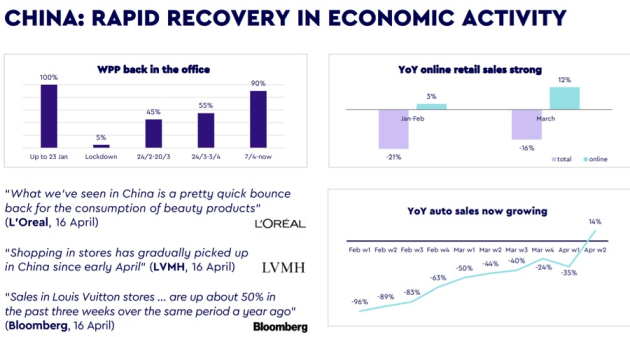
We can get clues to recovery in the advertising industry from behaviours in China, the second-largest advertising market in the world and the epicentre of the coronavirus crisis.
Advertising holding companies are reporting a resurgence of business in China following deep falls as the pandemic took hold.
According to WPP, business was down 21.3% in Greater China over the first quarter, hitting almost 30% in the month of March. China represents about 7% of WPP's revenue.
The rest of the world is still in isolation but life signs are returning in China.
At the end of April, WPP’s offices in China -- abandoned as everyone was told to stay at home -- were back to 90% occupancy with a rapid recovery in economic activity. WPP has about 5,000 staff in China.
Retail sales are improving and online retail sales have grown at a stronger rate. In the second week of April, automotive sales were up 14% year-on-year after falling 35%.
However, the recovery in China is not back to levels before the COVID-19 outbreak.
“Clearly, if you look at automotive sales, there's an element of pent-up demand,” WPP CEO Mark Read told analysts after releasing first quarter results. “We wouldn't necessarily expect that 14% to continue for the rest of the year.
“We are cautious, but I think that the lesson that we've learned is that the recovery can be very rapid. It does take four to six weeks for consumers to start to get back.”
WPP collected comments from luxury retailers.
L’Oreal: “What we’ve seen in China is a pretty quick bounce back for the consumption of beauty products.”
LVMH: “Shopping in stores has gradually picked up in China since early April.”
A slide from WPP's presentation to analysts:
At Omnicom, its events and field marketing businesses were all but shut in China earlier in the year as stay-in-home orders and restrictions on travel and large gatherings took effect.
But that’s starting to change.
“We are seeing some bright spots reemerging in China and other parts of Asia," says CEO John Wren.
“Our clients in China are spending because China is basically back open again.
“People are actually going to car dealerships in China."
Pandemic behaviour
Restrictions are being relaxed gradually across China, with some businesses reopening while others are staying shut for some time.
Magna reports that television consumption in China peaked in early February during the mandatory work from home period.
Daily average TV ratings reached 16.3%, compared to around 10.5% in the weeks before the Chinese New Year festival and 15.6% during the festival.
Digital consumption also peaked when everyone sat at home, with traffic boosted across all types of content. News, online gaming, social, and video were the winners.
“As media consumption slowly goes back to normal, news, social, and video are expected to remain the largest share of digital time spent,” says Magna.
As more businesses reopen and more people return to work, Magna sees TV time returning to close to 2019 levels, or about 140 minutes per day on average, compared to 120 minutes a year ago.
Radio consumption remained relatively stable throughout the lockdown.
The crisis has clarified what really matters to many people. Around the world, despite different systems and experiences, individuals are being united by the common experience of the pandemic.
A study by FleishmanHillard finds that many consumer behaviour, changed during the pandemic, will persist past the crisis.
“What we have seen so far as cities in China begin their early stages of recovery, is a sense of purpose and determination, and a recognition of personal responsibility,” says Rachel Catanach, chair of FleishmanHillard’s COVID-19 Taskforce and president and senior partner for Greater China.
“Workplaces are arranged to maintain healthy distances while still enabling operations to resume.
“Employers can acknowledge concerns about the health and safety of their employees and customers, but still create an expectation of progress, even if there may be occasional setbacks.
“With ongoing communications to inform and engage all stakeholders as the return to work rolls out, we believe that organizations can encourage productivity and shared innovation that can speed a sustainable recovery.”
Economists also have been keenly watching China for clues as to what will happen in the rest of the world.
“As we move towards a gradual reopening of the economy in parts of the world outside of China, we have been keenly watching the developments in China to see how various sectors of the economy are normalising and how this experience can inform our view on the rest of the world,” write analysts at Morgan Stanley in a note to clients.
“In China, the manufacturing and construction sector has had a relatively fast pace of recovery but the consumption services sectors are recovering at a relatively slower pace.”
According to official data from China, GDP contracted 6.8% in the first quarter, the first time that negative economic growth has been recorded since quarterly figures started in 1992. Retail sales were down 15.8% in March.
China, the world’s biggest producer of consumer goods, will have to wait for the rest of the world to get on its feet. Its customers -- the rest of the world -- are in lockdown.
Have something to say on this? Share your views in the comments section below. Or if you have a news story or tip-off, drop us a line at adnews@yaffa.com.au
Sign up to the AdNews newsletter, like us on Facebook or follow us on Twitter for breaking stories and campaigns throughout the day.



